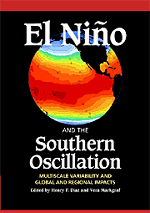Book contents
- Frontmatter
- Contents
- Contributors
- Acknowledgments
- Preface
- SECTION A Global and Regional Characteristics and Impacts of ENSO Variability
- 1 ENSO and Climatic Variability in the Past 150 Years
- 2 Understanding and Predicting Extratropical Teleconnections Related to ENSO
- 3 Global Modes of ENSO and Non-ENSO Sea Surface Temperature Variability and Their Associations with Climate
- 4 Multiscale Streamflow Variability Associated with El Niño/Southern Oscillation
- 5 El Niño/Southern Oscillation and the Seasonal Predictability of Tropical Cyclones
- 6 Climate and ENSO Variability Associated with Vector-Borne Diseases in Colombia
- SECTION B Long-Term Changes in ENSO: Historical, Paleoclimatic, and Theoretical Aspects
- Index
5 - El Niño/Southern Oscillation and the Seasonal Predictability of Tropical Cyclones
from SECTION A - Global and Regional Characteristics and Impacts of ENSO Variability
Published online by Cambridge University Press: 04 August 2010
- Frontmatter
- Contents
- Contributors
- Acknowledgments
- Preface
- SECTION A Global and Regional Characteristics and Impacts of ENSO Variability
- 1 ENSO and Climatic Variability in the Past 150 Years
- 2 Understanding and Predicting Extratropical Teleconnections Related to ENSO
- 3 Global Modes of ENSO and Non-ENSO Sea Surface Temperature Variability and Their Associations with Climate
- 4 Multiscale Streamflow Variability Associated with El Niño/Southern Oscillation
- 5 El Niño/Southern Oscillation and the Seasonal Predictability of Tropical Cyclones
- 6 Climate and ENSO Variability Associated with Vector-Borne Diseases in Colombia
- SECTION B Long-Term Changes in ENSO: Historical, Paleoclimatic, and Theoretical Aspects
- Index
Summary
Abstract
Perhaps the most dramatic effect that El Niño has upon the climate system is in changing tropical cyclone characteristics around the world. This chapter reviews how tropical cyclone frequency, intensity, and areas of occurrence are altered in all of the cyclone basins by the phases of El Niño/Southern Oscillation (ENSO). In addition to ENSO, other global factors (such as the stratospheric Quasi-Biennial Oscillation) and local factors (such as sea surface temperature, monsoon intensity and rainfall, sea level pressures, and tropospheric vertical shear) can also help modulate tropical cyclone variability. Understanding how these various factors relate to tropical cyclone activity can be challenging owing to the fairly short record (on the scale of only tens of years) of reliable data. Despite this limitation, many of the variables that have been linked to tropical cyclones can be utilized to provide seasonal forecasts of tropical cyclones. Details of prediction methodologies that have been developed for the North Atlantic, Northwest Pacific, South Pacific, and Australian basin tropical cyclones are presented as well as the realtime forecasting performance for Atlantic hurricanes as issued by Prof. William Gray.
Introduction
Tropical cyclones are the costliest and deadliest natural disasters around the world, as the approximate 300,000 death toll in the infamous Bangladesh Cyclone of 1970 and the $26.5 billion (U.S.) in damages due to Hurricane Andrew in the southeast United States can attest (Holland 1993; Hebert et al. 1996).
- Type
- Chapter
- Information
- El Niño and the Southern OscillationMultiscale Variability and Global and Regional Impacts, pp. 149 - 182Publisher: Cambridge University PressPrint publication year: 2000
- 5
- Cited by



